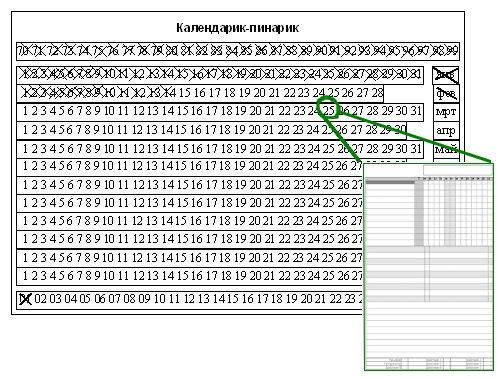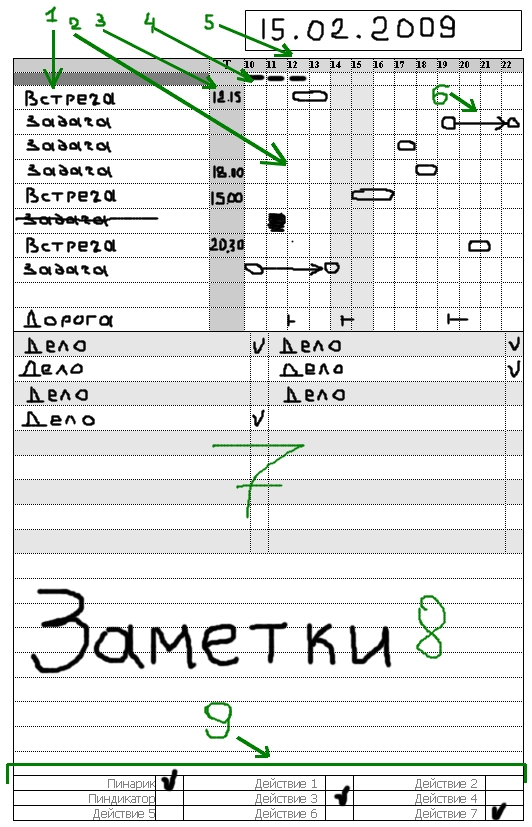Pinkar deep, or my paper organizer
The idea of a pinarian as a life time card on one sheet has been described for a long time and is well known. She even found incarnation in the virtual space, about which the respected Irokez wrote in the topic “Pinarik online” , with the submission of the respected McBernar (publication “Personal Time Management” ).
I have an established system of organizing personal work, the description of which is the subject of one of the following publications. The system uses a certain method and a bunch of PDAs, Outlook, some web services, however there are situations when there is a need to steer from the day in the afternoon. That is, to have a daily schedule on paper, especially since all the same the A5 format organizer on split rings is always with you, in which there is a pinbox and a strategy.
I have never liked traditional organizers with their linear “vertical” structure of the day. My approach requires the ability to have an overview of the whole day and flexibly handle tasks, but what if the schedule is on paper? How to deploy a pinar cell per day? Here's what it looks like:
')

The A5 format template in the .doc file is available here , the rest is below.
So, we will consider an example of the form with marked areas.

1. The area of tasks and events, which is time-bound by directive. Elements of a plan of this kind may not have the duration reflected in the area, but if the call should be made at 14.22 ... then this task is here.
2. Map of the time of day, analogue of the Gantt chart. A tremendous convenience is that you do not need to cram a new task for 11 hours between 10.30 and 11.30. You write it to the very bottom of the list, and in the time cell draw a circle. Everything, scanning from left to right the map of the day you perfectly see what and when it is planned. And on the drum, where it is recorded.
3. Column to indicate the exact start time of the task.
4. String for TM-maniacs. As in the penaric we cross out the days, so here we cross out the past hours. Ideally - an hour passed, crossed out a line fragment.
5. Actually hours column.
6. What I love my paper organizer for is the ability to transfer tasks. Try to repeat this trick on a sheet of classic format. The task itself is in place, only time has changed.
7. To-do area. This is what is written that does not have a time reference. It can be grouped according to different characteristics, for example, it is convenient to have telephone calls in one group, or to combine them by territorial affiliation. “Office”, “Bank”, “Object”, “ABS Firm” and so on.
8. The area of arbitrary notes.
9. And this is the daily check list. It contains nine stable tasks-elements, the execution of which is marked with a tick. For example, “Pinarian Marked”, “Pindicator Filled” and other things that, for example, we want to make a habit. “Three stops on foot”, “100 push-ups”, “New book - 30 minutes” and so on. Became a habit - change the form, only business.
A good stimulating effect is provided by the fixation of large strokes of what was happening in reality at a given day. If the plan is indicated at the top of the lines, then the fact is crossed out at the bottom, preferably in a different color. One task drove away, the second was not done at all, and from 11 to 12 it was generally done off-schedule, I don’t remember stupid from 16 to 17. It's okay, this is life, this is normal, but food for thought is still there.
The archive of such schedules is a fantastically valuable material. Once, he drove by launching a project office in a well-known, famous bank. "Dossier" - three hundred A4 sheets. Reads like a detective tragicomedy with an optimistic ending, you can write a book.
Made such a schedule format in Outlook, through custom user views. In general, nothing, and Ganttik turns out to be convenient, but such a structure is not synchronized with the communicator, and this kills all personal technology in the bud.
I have an established system of organizing personal work, the description of which is the subject of one of the following publications. The system uses a certain method and a bunch of PDAs, Outlook, some web services, however there are situations when there is a need to steer from the day in the afternoon. That is, to have a daily schedule on paper, especially since all the same the A5 format organizer on split rings is always with you, in which there is a pinbox and a strategy.
I have never liked traditional organizers with their linear “vertical” structure of the day. My approach requires the ability to have an overview of the whole day and flexibly handle tasks, but what if the schedule is on paper? How to deploy a pinar cell per day? Here's what it looks like:
')

The A5 format template in the .doc file is available here , the rest is below.
So, we will consider an example of the form with marked areas.

1. The area of tasks and events, which is time-bound by directive. Elements of a plan of this kind may not have the duration reflected in the area, but if the call should be made at 14.22 ... then this task is here.
2. Map of the time of day, analogue of the Gantt chart. A tremendous convenience is that you do not need to cram a new task for 11 hours between 10.30 and 11.30. You write it to the very bottom of the list, and in the time cell draw a circle. Everything, scanning from left to right the map of the day you perfectly see what and when it is planned. And on the drum, where it is recorded.
3. Column to indicate the exact start time of the task.
4. String for TM-maniacs. As in the penaric we cross out the days, so here we cross out the past hours. Ideally - an hour passed, crossed out a line fragment.
5. Actually hours column.
6. What I love my paper organizer for is the ability to transfer tasks. Try to repeat this trick on a sheet of classic format. The task itself is in place, only time has changed.
7. To-do area. This is what is written that does not have a time reference. It can be grouped according to different characteristics, for example, it is convenient to have telephone calls in one group, or to combine them by territorial affiliation. “Office”, “Bank”, “Object”, “ABS Firm” and so on.
8. The area of arbitrary notes.
9. And this is the daily check list. It contains nine stable tasks-elements, the execution of which is marked with a tick. For example, “Pinarian Marked”, “Pindicator Filled” and other things that, for example, we want to make a habit. “Three stops on foot”, “100 push-ups”, “New book - 30 minutes” and so on. Became a habit - change the form, only business.
A good stimulating effect is provided by the fixation of large strokes of what was happening in reality at a given day. If the plan is indicated at the top of the lines, then the fact is crossed out at the bottom, preferably in a different color. One task drove away, the second was not done at all, and from 11 to 12 it was generally done off-schedule, I don’t remember stupid from 16 to 17. It's okay, this is life, this is normal, but food for thought is still there.
The archive of such schedules is a fantastically valuable material. Once, he drove by launching a project office in a well-known, famous bank. "Dossier" - three hundred A4 sheets. Reads like a detective tragicomedy with an optimistic ending, you can write a book.
Made such a schedule format in Outlook, through custom user views. In general, nothing, and Ganttik turns out to be convenient, but such a structure is not synchronized with the communicator, and this kills all personal technology in the bud.
Source: https://habr.com/ru/post/60446/
All Articles